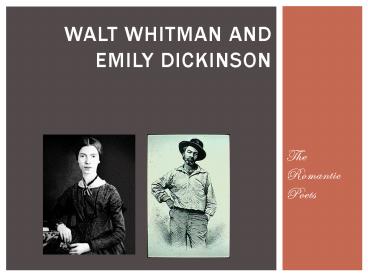The Romantic Poets - PowerPoint PPT Presentation
1 / 14
Title:
The Romantic Poets
Description:
WALT WHITMAN AND EMILY DICKINSON The Romantic Poets WALT WHITMAN 1819-1892 He came from a large family (seven brothers ... – PowerPoint PPT presentation
Number of Views:132
Avg rating:3.0/5.0
Title: The Romantic Poets
1
Walt Whitman and Emily Dickinson
- The Romantic Poets
2
Walt Whitman
- 1819-1892
3
Background
- He came from a large family (seven brothers and
sisters) - Had the opportunity to live in both a country
setting and the city of New York (Brooklyn) - He attended school until he was eleven, then
worked as a printers assistant and a teacher
4
Background
- Worked in journalism until the age of thirty
- Moved to New Orleans to continue journalism
- Eventually returned to New York as a journalist
and part-time carpenter/contractor. - He kept journals and diaries that became the
basis for much of his literary work.
5
Poetry
- Based on cadence, which is the long, easy sweep
of sound that echoes the Bible and the speeches
or orators and preachers. - Cadence was the base for free verse, which is
poetry without rhyme or meter. - In 1855, he published his most important
collection of poetry, Leaves of Grass. He revised
it nine times before his death in 1892.
O captain! my captain! our fearful trip is
doneThe ship has weathered every rack, the
prize we sought is wonThe port is near, the
bells I hear, the people all exulting,While
follow eyes the stead keel, the vessel grim and
daring.
6
Walts Style
- Frequently uses catalogs the piling up of images
or concrete details - Example from Song of Myself
- My tongue, every atom of my blood, formed from
this soil, this air/Born here of parents born
here from parents the same, and their parents the
same (lines 6-7)
7
Style
- His catalogs here represent the spiritual unity
among all forms of being. - He frequently uses parallelismthe repeated use
of phrases, clauses, or sentences that are
similar in structure or meaning. - Use of parallelism helps to create a sense of
unity within his poetry and it also provides a
structure, creates a rhythm, and emphasizes
important ideas.
8
Style
- Uses free verse verse that has irregular meter
and line length - Whitman was the first American poet to use free
verse. - His use of free verse allowed him to express
himself without restraint
9
Emily Dickinson
We never know how high we areTill we are called
to riseAnd then, if we are true to plan,Our
statures touch the skies.
- 1830-1886
Hope is a thing with feathersThat perches in the
soul,And sings the tune without wordsAnd never
stops at all.
10
Background
- Born into a wealthy New England family and had a
happy childhood. Everyone assumed she would grow
up to marry and have a family. - At 24, her father took her on a business trip to
separate Emily from a drastic situationshe had
fallen in love with a married man she could never
marry.
Behavior is what a man does, not what he thinks,
feels, or believes.
Beauty is not caused. It is.
11
Background
- Ironically, while on the trip, she fell in love
with another married man, Charles Wadsworth, a
Presbyterian minister. She was once again
separated from the man she loved. - She then withdrew from all social life except
involving her family.
12
Emily alone!
- Within a few years, Emily was dressing in all
white and lived in total seclusion. - Her only activities included writing her poems
and household chores.
13
Emilys Poetry
- She only printed a handful of her poems during
her lifetime. - However, she made sure that she left bundles of
her poems to be found after her death. - Family and friends edited her poems and published
them in numerous installments. - Her poems were brief and contained brilliant
metaphors.
14
Emilys Style
- Uses unconventional punctuation and
capitalization - Most of her lines and stanzas are very brief
- Most of her poetry is writing in quatrains
- Usually, only the second and fourth lines in her
quatrains rhyme. - She often uses slant or partial rhymes.
- She has a tendency to use figurative language to
convey her ideas.































